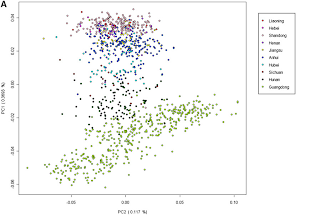Another paper which shows that post-Last Ice Age mtDNA evolution did not proceed "slowly", i.e., with a rate similar to that inferred from human-chimpanzee divergence. As the authors note, the mechanism for the "slow" mutation rate, i.e. purifying selection of deleterious mtDNA mutations was "sluggish".
Note also how post-Last Ice Age population expansions are responsible for the weakness of purifying selection: as populations expand, even slightly deleterious alleles (and even non-deleterious ones) have a higher chance of surviving in a population. Genetic diversity increases faster in an expanding than in a static population.
From the paper:
In conclusion, human mitochondrial DNA clock is time-dependent mainly because of the time-dependence of purifying selection. There is also evidence that purifying selection has been counteracted by other population genetic factors during the course of human history. Our results imply that the proportion of synonymous substitutions has alternated between growth and decrease. This interpretation is strengthened given the shape of the human mtDNA tree, which reflects the bottlenecks and subsequent population expansions associated with the out-of-Africa migration and the hectic climatic conditions of the last glacial period. The wavy growth of the proportion of synonymous substitutions implies biases in the published correction of the mtDNA clock, which assumed a monotonic growth curve [15]. Therefore, the clock of synonymous substitutions should be preferred. In addition, it seems that a good consensus has been achieved on the rate of accumulation of synonymous substitutions in human mtDNA, which applies at the population as well as the interspecies level (this study, [15]).
[15] is Soares et al. (see below)
Related:
PLoS ONE doi:10.1371/journal.pone.0008260
Explaining the Imperfection of the Molecular Clock of Hominid Mitochondria
Eva-Liis Loogväli et al.
Abstract
The molecular clock of mitochondrial DNA has been extensively used to date various genetic events. However, its substitution rate among humans appears to be higher than rates inferred from human-chimpanzee comparisons, limiting the potential of interspecies clock calibrations for intraspecific dating. It is not well understood how and why the substitution rate accelerates. We have analyzed a phylogenetic tree of 3057 publicly available human mitochondrial DNA coding region sequences for changes in the ratios of mutations belonging to different functional classes. The proportion of non-synonymous and RNA genes substitutions has reduced over hundreds of thousands of years. The highest mutation ratios corresponding to fast acceleration in the apparent substitution rate of the coding sequence have occurred after the end of the Last Ice Age. We recalibrate the molecular clock of human mtDNA as 7990 years per synonymous mutation over the mitochondrial genome. However, the distribution of substitutions at synonymous sites in human data significantly departs from a model assuming a single rate parameter and implies at least 3 different subclasses of sites. Neutral model with 3 synonymous substitution rates can explain most, if not all, of the apparent molecular clock difference between the intra- and interspecies levels. Our findings imply the sluggishness of purifying selection in removing the slightly deleterious mutations from the human as well as the Neandertal and chimpanzee populations. However, for humans, the weakness of purifying selection has been further exacerbated by the population expansions associated with the out-of Africa migration and the end of the Last Ice Age.
Link















